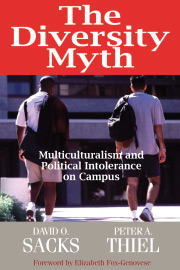“ORlENTATION is designed to disorient you”, announced Stanford professor James Adams to an auditorium of 1,600 puzzled freshmen at the beginning of the new school year. Assembled for one of many orientation-week programs on “diversity,” the freshmen soon learned what he meant. A lesbian activist spoke first about “challenging your sexuality,” and encouraged the 17- and I8-year-old students to “overcome” their “fears of being queer.” Next, a black musician performed an electric-guitar solo as police sirens wailed in the background. He concluded his demonstration by dropping suddenly to the floor and convulsing his body in a re-enactment of the Rodney King beating.Then it was Professor Adams’s turn. Dividing the students by last name, he asked each segment to assume the voice of an animal—G through L, an ape; M through S, a seal; and so on. “Then, on his cue, we made our animal’s sound at the top of our lungs,” explained a freshman participant in the fall of 1992. As the resulting cacophony of barks, hoots, and whoops filled the auditorium, Professor Adams exulted, “By the time you leave Stanford, you should be completely disoriented.”
And Professor Adams is not exaggerating. Life in the PC academy can be discombobulating for students out of step with the latest political fashions, and this is nowhere more true than at Stanford, where former President Donald Kennedy declared that the university’s multicultural venture was “a bold experiment that must succeed.” In almost every area of university life—the classroom, in the dorm room, and even in the bathroom—“diversity training” continues throughout the year.
In the Classroom: All freshmen must take “Cultures, Ideas, and Values” (CIV), the multi-“track” requirement that replaced Stanford’s famous Western Culture course. The theme is deconstruction, with a vengeance. The Bible is still read, for instance, but many professors teach that Genesis is rife with sexism, and some even make St. Paul politically correct by saying that he may have been a homosexual. Shakespeare is also still studied in all the tracks, but The Tempest is now viewed from a “slave perspective” and is made to serve as a case study in Western imperialism.
The political motif becomes more explicit in Stanford’s mandatory freshman English classes, where students are required to fill out grant proposals for their professors’ favorite community—service agencies. Options include homeless-advocacy projects, AIDS support groups, and environmental-action leagues (no Michael Milken defense fund). Freshmen are also enlisted to answer telephones at Stanford’s center for Public Service and make field trips to inner-city East Palo Alto. After all, if there are no Great Books anyway, what is the value of reading and writing?
In the Dorm: Many freshmen will find themselves assigned to “theme” houses, residences in which the staff organize programing around a particular set of political issues. In Stanford’s “1960s” theme dorm, the focus is on “the origins of the ecology movement, the women’s movement, and gay and lesbian activism.” Other dorms organize programing around a racial theme (Ujamaa House for blacks, Casa Zapata for Hispanics, Muhwekma-taw-ruk for American Indians, and Okada for Asians). These dorms primarily have the effect of removing a large number of minority students from the rest of the university. So much for pluralism.
Not surprisingly, racial theme dorms often are rather uncomfortable: places for the few students forced to live there who are not members of the preferred group. Several years ago, two freshmen were thrown out of Ujamaa House after they challenged a minority student’s assertion that Beethoven was black. (The minority student had read that “fact” in a book in the Ujamaa library.)
A slightly different approach to consciousness-raising came from “Project Awareness,” a radical Latino organization. The group staged mock kidnappings all over campus to demonstrate the way citizens supposedly were being abducted by right-wing governments in Latin America. Dressed in camouflage, wearing masks, and brandishing weapons, these student activists would burst into cafeterias to “abduct” students and professors. All was going according to plan, until one night in Wilbur dorm some student diners became convinced that the kidnapping in progress was real. The diners proceeded to beat up the “kidnappers,” and Project Awareness came to an abrupt halt.
In the Church: Religiously inclined freshmen may be surprised to find that Bibles have been removed from Stanford’s Memorial Church. The church staff has deemed the books exclusionary toward people of other faiths. Meanwhile, the staff has found other ways to keep busy. In October of 1993, for instance, Dean Diana Akiyama presided over the church’s first homosexual marriage. Her decision to conduct the “commitment ceremony” (“wedding” is now a disfavored term) was based on her acknowledgment that doing so would be “politically risky, but theologically compelling.” While gay marriages are “theologically compelling,” apparently, Bibles are not.
In the Bathroom: Freshmen may wish to tread carefully around their “resident assistants” (RAs),upperclass advisors who are particularly devoted to the multiculturalist experiment. RA Marcus Mabry tried to extend diversity training into the dormitory toilets: “I tried soft sells like putting up cartoons of episodes in African-American history in the bathroom stalls, but some people complained, ‘I can’t escape this multiculturalism stuff anywhere.’” Wonder why?








